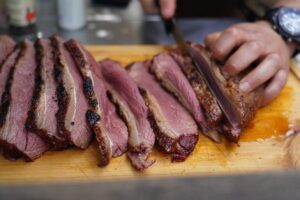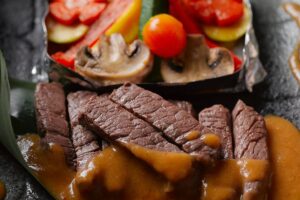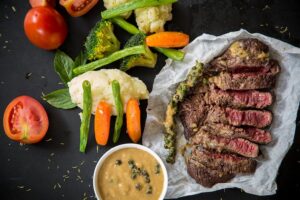Corned beef has become a beloved dish across the globe, known for its savory and hearty flavor. In this article, we’ll delve into the age-old debate of baked versus boiled corned beef.

These two cooking methods offer distinct textures, flavors, and overall dining experiences.
However, everyone has their preferences and you should be fully aware of what your options are. So, let us start!
A Brief History
To truly appreciate the art of cooking corned beef, it’s essential to understand its origins. Corned beef, historically preserved with coarse salt (resembling corn kernels), emerged as a method of extending the shelf life of meat.
Traditionally, beef brisket is the cut of choice, marinated in a brine of spices, curing salt, and water. The result is a flavorful and tender meat, ready to be transformed into a delectable dish.
Cooking Time and Temperature
Cooking Time
Baked Corned Beef: Baking corned beef generally requires a longer cooking time compared to boiling.
The low and slow method in the oven, typically set at temperatures ranging from 300°F to 350°F (150°C to 175°C), allows for a gradual breakdown of collagen and connective tissues in the meat.
This extended cooking time contributes to the tenderness and flavor development of the corned beef. The result is often a well-cooked, flavorful dish that has absorbed the complexities of any applied seasonings or marinades.
Boiled Corned Beef: Boiling is a quicker cooking method compared to baking. The meat is submerged in boiling or simmering water, and the high temperature, around 212°F (100°C), accelerates the cooking process.
While boiling may not provide the same depth of flavor as baking, it is a practical and time-efficient option for those seeking a delicious corned beef meal without the longer wait.
Boiled corned beef is generally ready in a shorter period, making it suitable for those with time constraints or looking for a straightforward cooking approach.
Temperature
Baked Corned Beef: The baking process involves cooking corned beef at a moderate to low temperature, typically between 300°F to 350°F (150°C to 175°C). This lower temperature allows for a slow and controlled cooking process.
The result is a well-cooked interior that retains the natural juices of the meat, resulting in a tender and flavorful dish.
The application of lower temperatures also allows for the development of a savory crust on the exterior, enhancing the overall taste and texture.
Boiled Corned Beef: Boiling, by its nature, involves a higher cooking temperature, as the meat is submerged in boiling or simmering water. The temperature is maintained at approximately 212°F (100°C).

This elevated temperature facilitates a faster cooking process, making it an efficient choice for individuals who prioritize speed in their meal preparation.
While boiling may not produce the same caramelization or outer crust as baking, it effectively achieves a well-cooked and moist corned beef.
The choice between baked and boiled corned beef in terms of cooking time and temperature depends on individual preferences, available time, and desired outcomes.
Baked corned beef, with its longer cooking time and moderate temperature, offers a slower, flavor-enhancing process.
On the other hand, boiled corned beef, with its quicker cooking time at higher temperatures, provides a practical and time-efficient option for those seeking a delicious and straightforward meal.
Texture
Baked Corned Beef: Baked corned beef is known for its unique texture that combines a firm and slightly dry exterior with a tender and succulent interior.
The application of a rub or glaze before baking contributes to the formation of a flavorful crust on the outer layer, creating a delightful contrast to the juicy and well-cooked meat beneath.
The baking process allows for caramelization to occur on the surface of the meat, enhancing the overall texture.
This caramelization not only contributes to a more appealing appearance but also adds depth to the flavor profile.
The slow and controlled cooking at moderate temperatures helps break down connective tissues, resulting in a more tender texture.
Boiled Corned Beef: Boiled corned beef tends to have a more uniformly moist and succulent texture throughout the meat.
The slow simmering in liquid, typically water or broth, facilitates the breakdown of collagen and connective tissues, resulting in a tender and juicy outcome.
The texture is consistent, lacking the contrasting firmness of the exterior found in baked corned beef.
The boiling process ensures that the meat retains a higher level of moisture, creating a more homogenous texture.
While the outer layer may not have the same caramelization as baked corned beef, the overall tenderness and juiciness make boiled corned beef appealing to those who prefer a consistently moist bite.
The choice between baked and boiled corned beef significantly influences the texture of the final dish.
Baked corned beef offers a unique contrast between the firm outer layer and tender interior, with caramelization adding complexity to both texture and flavor.
Boiled corned beef provides a more uniformly moist and succulent texture, making it an excellent choice for those who appreciate consistent tenderness throughout the meat.
Individual preferences for texture, along with considerations of preparation time and desired flavors, play a key role in deciding between these two cooking methods.
Flavor

Baked Corned Beef: Baked corned beef is known for its rich and complex flavor profile.
The slow cooking process at moderate to low temperatures allows the meat to absorb and meld with the flavors of any applied rubs, glazes, or seasonings.
The result is a dish that not only has a well-cooked and tender interior but also boasts a flavorful outer crust due to caramelization.
The caramelization on the surface of the meat during baking contributes to the depth of flavor. This process enhances the savory notes, creating a more robust and layered taste.
The exterior crust, infused with the chosen seasonings, complements the juicy and flavorful interior, providing a satisfying eating experience.
Boiled Corned Beef: Boiled corned beef, while simpler in terms of preparation, offers a straightforward and authentic beef flavor.
The meat is submerged in water or broth, and traditional ingredients like onions, garlic, and spices are added to enhance the overall taste.
The cooking liquid extracts flavors from the meat, resulting in a savory and mildly seasoned broth.
Boiling allows the natural flavors of the corned beef to shine. The simplicity of the cooking method ensures that the beef’s inherent taste is preserved, offering a more unadulterated beef flavor.
While the outer layer may not have the same caramelization as in baking, the meat is moist and succulent.
Baked corned beef is celebrated for its rich, complex taste with layers of seasoning and caramelization, while boiled corned beef provides a more straightforward and authentic beef flavor.
The decision ultimately depends on individual preferences, with some favoring the enhanced and nuanced taste of baked corned beef, while others appreciate the simplicity and natural flavors of boiled corned beef.
Wrap Up
When deciding between baked and boiled corned beef, the choice ultimately rests on personal preference. Some savor the rich flavor and tenderness of baked, while others appreciate the simplicity and heartiness of boiled.
In the end, whether baked or boiled, corned beef remains a household favorite. Experiment, add your flair, and revel in the joy of sharing a delicious meal with loved ones.
Remember, you can combine the elements of each method to create your signature corned beef masterpiece.
